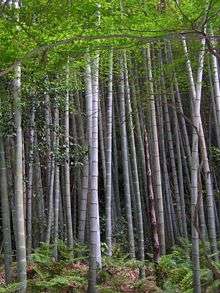Phyllostachys edulis
| Phyllostachys edulis | |
|---|---|
 | |
| Bamboo forest | |
| Scientific classification | |
| Kingdom: | Plantae |
| (unranked): | Angiosperms |
| (unranked): | Monocots |
| (unranked): | Commelinids |
| Order: | Poales |
| Family: | Poaceae |
| Genus: | Phyllostachys |
| Species: | P. edulis |
| Binomial name | |
| Phyllostachys edulis (Carrière) J.Houz., 1906 | |
| Synonyms[1] | |
| |

Phyllostachys edulis, moso bamboo,[2] or tortoise-shell bamboo,[2] or mao zhu (Chinese: 毛竹; pinyin: máozhú), (Japanese モウソウチク(孟宗竹)) is a temperate species of giant timber bamboo native to China and Taiwan and naturalised elsewhere.[3] The edulis part of the Latin name is a reference to the fact that it produces edible shoots. This bamboo can reach heights of up to 28 m (92 ft).[4] This particular species of bamboo is the most common species used in the bamboo textile industry of China. Its physical properties boast an average breaking tenacity more than three times that of cotton, wool, rayon, or polyester.[5]
Ecology
Phyllostchys edulis spreads using both asexual and sexual reproduction. The most common and well known for this plant is asexual reproduction. This occurs when the plant sends up new culms from underground rhizomes. The culms grow quickly and reach a height of 90 ft or more (this is depending on the age and health of the plant). In mature individuals, the culms in young plants grow taller and wider in diameter as the general plant reaches maturity, but once the individual culm stops growing it will not grow again. P. edulis also flowers and produces seed, and it does so every half century or so, but it has a sporadic flowering nature and there are always a few individual plants in flower somewhere. The seeds fall from the mature culms in the hundreds of thousands and are quick to germinate. Mice, field rats and other rodents take notice of the bounty of seed, this results in the loss of many of the seeds, but within a few weeks the surviving few seeds would have germinated. The first culm from a seedling will not get much taller than a few inches at most, and may be as thin as 2mm, but with every new culm sent up from developing rhizomes, the grove of plants will grow in height and cane diameter.
Polyporus phyllostachydis (Sotome, T. Hatt. & Kakish.), is a fungus species, known from Japan, that grows on the ground on the living or dead roots of the Phyllostachys heterocycla bamboo.
Cultivars
Cultivars include:
- Phyllostachys edulis 'Bicolor'
- Phyllostachys edulis 'Kikko' or 'Kikko-Chiku' (Syn.: Phyllostachys edulis var. heterocycla)
- Phyllostachys edulis 'Subconvexa' (Syn.: Phyllostachys heterocycla f. subconvexa, Phyllostachys pubescens 'Subconvexa')
- Phyllostachys edulis 'Nabeshimana', (Syn.: Phyllostachys heterocycla f. nabeshimana, Phyllostachys pubescens f. luteosulcata)
Biochemistry
Compounds isolated from P. edulis include:
- Hydroxycinnamic acids[6]
- Chlorogenic acids[6]
- chlorogenic acid (3-(3,4-dihydroxycinnamoyl)quinic acid)
- 3-O-(3‘-methylcaffeoyl)quinic acid
- 5-O-caffeoyl-4-methylquinic acid
- 3-O-caffeoyl-1-methylquinic acid (C17H20O9, exact mass : 368.110732).
- Flavones
- tricin[7][8]
- 7-O-methyltricin [8]
- Glycosylated flavones[7][9]
- orientin [7][9]
- isoorientin [7][9]
- vitexin [7][9]
- isovitexin [7][9]
- 5,7,3'-trihydroxy-6-C-β-D-digitoxopyranosyl-4'-O-β-D-glucopyranosyl flavonoside[7]
- 5,3',4'-trihydroxy-7-O-β-D-glucopyranosyl flavonoside[7]
- 5,4'-dihydroxy-3',5',-dimethoxy-7-O-β-D-glucopyranosyl flavonoside[7]
- 5,7,3',4'-trihydroxy-6-C-(α-L-rhamnopyranosyl-[1→6])-β-D-glucopyranosyl flavonoside[7]
References
- ↑ "World Checklist of Selected Plant Families". Retrieved 31 May 2014.
- 1 2 "USDA GRIN Taxonomy". Retrieved 31 May 2014.
- ↑ Zheng-ping Wang & Chris Stapleton. "Phyllostachys edulis". Flora of China. Missouri Botanical Garden, St. Louis, MO & Harvard University Herbaria, Cambridge, MA. Retrieved 24 February 2014.
- ↑ Lewis, Daphne; Carol A. Miles (2008). Farming Bamboo. Lulu.com. pp. 155–165. ISBN 978-1-4357-0131-1.
- ↑ http://organicblanket.info/2013/02/17/analysis-of-bamboo-textile-properties/
- 1 2 Identification and Antioxidant Activity of Novel Chlorogenic Acid Derivatives from Bamboo (Phyllostachys edulis). Mee-Hyang Kweon, Han-Joon Hwang, and Ha-Chin Sung, J. Agric. Food Chem., 2001, 49 (10), pp 4646–4655
- 1 2 3 4 5 6 7 8 9 10 Antioxidant properties of major flavonoids and subfractions of the extract of Phyllostachys pubescens leaves. Guo, X. F., Yue, Y. D., Tang F., Wang, J., Yao, X. (2012). Journal of Food Biochemistry
- 1 2 Phyllostachys edulis Compounds Inhibit Palmitic Acid-Induced Monocyte Chemoattractant Protein 1 (MCP-1) Production. Higa, J. K., Liang, Z., Williams, P. G., & Panee, J. (2012). PLOS ONE, 7(9), e45082.
- 1 2 3 4 5 Simultaneous determination of seven effective constituents in the leaves of bamboo by reversed phase high performance liquid chromatography (RP-HPLC). Yong-chun Jin, Hua-liang Liu and Ke Yuan, . Med. Plants Res, 2011, 5(32), pp 5630-5635
See also
| Wikispecies has information related to: Phyllostachys edulis |
| Wikimedia Commons has media related to Phyllostachys edulis. |